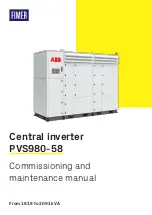
1.8.4
THE NATURAL GAS SYSTEM
A typical natural gas system is shown in Figure 1.10. The maxi-
mum pressure at which the gas can enter a building is established
by code and may vary from area to area. A primary regulator is
required to reduce gas supply pressures to the required safe level
before the gas enters a structure.
The primary regulator may or may not be provided by the gas
supplier. The gas distribution company will usually provide piping
from the main distribution line to the generator site. It is the respon-
sibility of the gas supplier to ensure that sufficient gas pressure is
available to operate the primary regulator.
From the primary regulator, gas flows to the generator connection.
A flexible length of gas line is required between rigid piping and
the gas connection at the generator. The generator fuel system
consists of an electrical fuel shutoff valve/regulator assembly and
a gas actuator.
The secondary regulator reduces gas pressure to about five inches
of water column before the gas Is delivered to the actuator.
NOTE:
Gas pressure from the primary regulator (supplied by the
installing contractor) to the generator's fuel shutoff valve should
not exceed 14 inches of water column.
Follow the local codes on selecting the required AGA approved,
and UL listed, for NG application flexible portion of the fuel line
(supplied by the installing contractor).
1.8.5
LP GAS VAPOR WITHDRAWAL SYSTEM
This type of system utilizes the vapors formed above the liquid
fuel in the supply tank (see Figure 1.11). Approximately 10 to 20
percent of the tank capacity is needed for fuel expansion from
the liquid to the vapor state. Gas pressure requirements for an LP
vapor system at the frame of the generator are the same as those
listed for natural gas in "The Natural Gas System". See Table 1 for
information regarding the vapor capacity of LP tanks. The installer
should be aware of the following:
• When ambient temperatures are low and engine fuel consump-
tion is high, the vapor withdrawal system may not function
efficiently.
• Ambient temperatures around the supply tank must be high
enough to sustain adequate vaporization or the system will not
deliver the needed fuel volume.
• In addition to the cooling effects of ambient air, the vaporization
process itself provides an additional cooling effect.
1.8.6
GASEOUS FUEL SYSTEM PIPING
NOTE:
The information below is to assist in planning gaseous fuel
installation. In NO WAY should this information be interpreted
to conflict with applicable fuel gas codes. Contact the local
jurisdiction if questions arise.
The following general rules apply to piping used in gaseous fuel
systems:
• The piping should be of black iron, rigidly mounted and pro-
tected against vibration.
• Install the supplied length of flexible hose between the generator
connection point and rigid piping.
The supplied flexible hose is not to be installed
underground or in contact with ground. The
flexible hose is for in-line installation only.
Bends, kinks or off-center in-line installation of
flexible hose is NOT allowed.
• Piping must be of the correct size to maintain the required sup-
ply pressures and volume flow under varying conditions (see
Calculating volumetric Flow Rate and Pipe Size).
• Installed piping must be properly purged and leak-tested, in
accordance with applicable codes and standards.
• Use an approved pipe sealant or joint compound on all threaded
fittings, to reduce the possibility of leakage.
NOTE:
In the absence of local purging and leak test standards, NFPA
No. 54 may be used as a guide.
8
General Information
Summary of Contents for Stationary Emergency Generator
Page 21: ...19 Operation Figure 3 6 Nexus to RTS Nexus Smart Switch Drawing 0H7453 C ...
Page 24: ...Part No 0H8218 Revision F 05 08 12 Printed in U S A ...
Page 25: ......
Page 26: ......











































